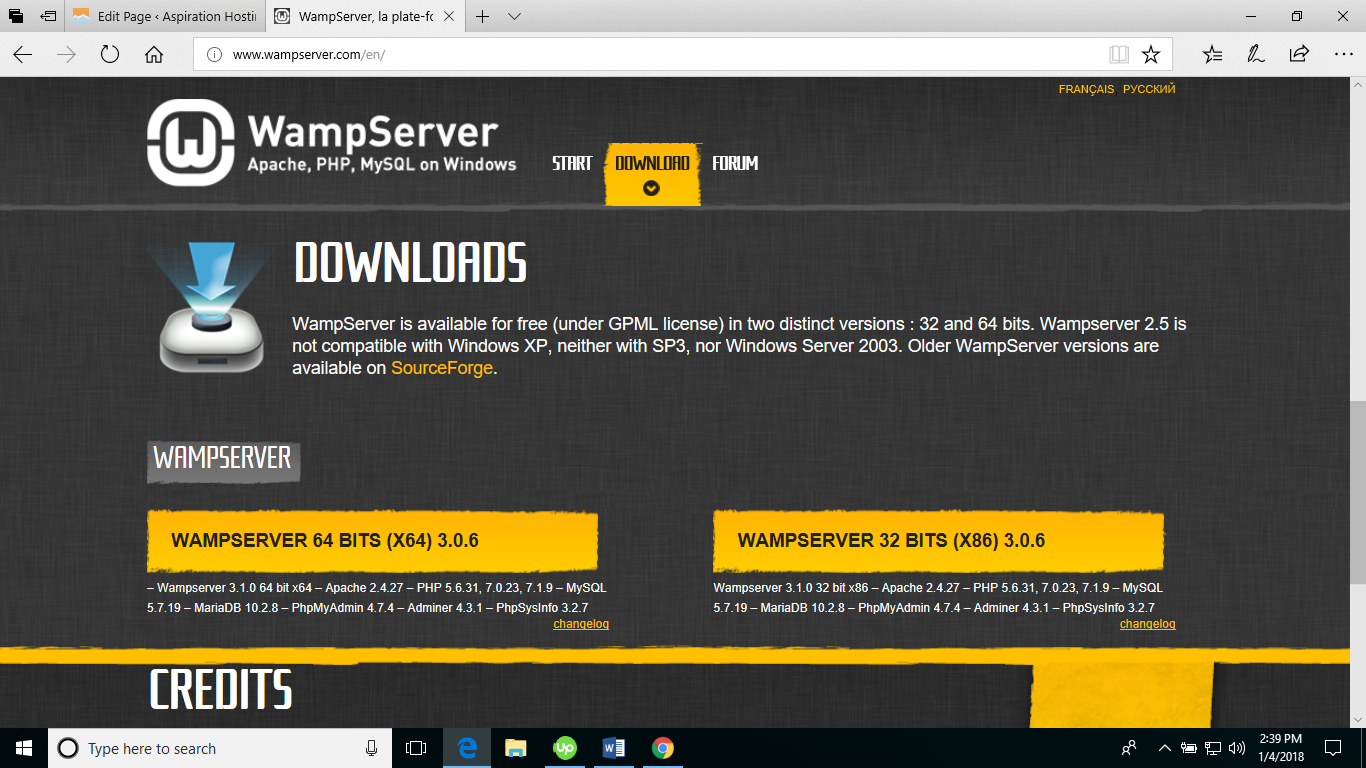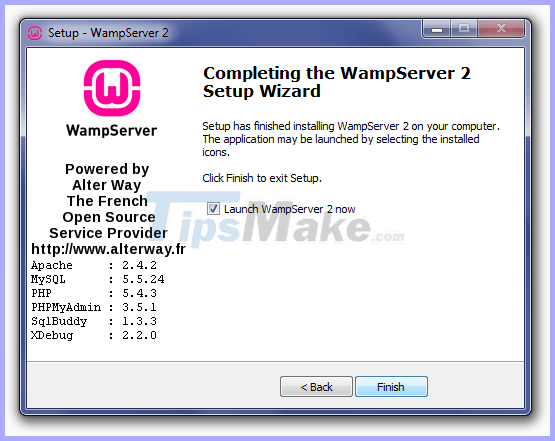Professional developers always prefer to test their projects locally before they make them live. And if you also wish to test your site locally before you actually make it live for the users, then install WAMP on your Windows computer and begin the testing now. In this tutorial guide, I will show you how to install WAMP on Windows machine effortlessly.
How to download and install WampServer for Windows 10 PC/laptop. Now let’s just move to the next section to share the steps you have to follow to download WampServer for Windows PC. So here we go: Download the WampServer installer file from the link above. Save the downloaded file to your computer. WampServer is a Windows web development environment. It allows you to create web applications with Apache2, PHP and a MySQL database. Alongside, PhpMyAdmin allows you to. The goal of Wamp.NET is to give developers multiple environments in which to develop websites in order to match the environment (e.g. Webserver, PHP Version, Database etc.) where the websites are being hosted. Sites created in Wamp.NET are completely independent from Webserver and PHP version. You can change the assigned. Important: Before installing Apache 2.4.47, the Wampserver 3.2.5 update is necessary. It is also essential to have previously installed the Visual C Redistributable Packages VC 2015-2019 (VS16) 4 or more. See the bottom of this page for download links.
First off, for all the beginners it is essential to understand the purpose of using WAMP and the significance of WAMP. Basically, WAMP stands for Windows (operating system), Apache (web server), MySQL (database), and PHP programming language. It is a popular alternative of XAMPP for Windows. However, you can use XAMPP as well and it doesn’t take much time to install XAMPP either. But developers may prefer to use WAMP since it is specifically crafted for Windows only. Unlike, XAMPP, which can be used for Linux and Mac OS as well. However, both the platforms are equally stable and provide the same functionality.
So you can choose any platform amongst the two to fulfill the objective. But all those who are searching for guidance on how to install WAMP on Windows system should follow the below-given steps. So let’s get going!!
How to Install WAMP on Windows
Below are the detailed steps on how to install WAMP that you need to follow for a successful WAMP installation.
Follow these steps to install WAMP
Step 1: Download the WAMP Server
Go to the official website https://www.wampserver.com/en/ and download the WampServer setup. There are two versions of WampServer are available i.e. 64-bits (x64) and 32-bits (x86), choose according to your computer’s configuration.
As soon as you will click on the download option, a pop up will appear showing some warnings. Just don’t worry about these warning rather simply click on the link “download directly” like shown below and move ahead with the download process.
Step 2: Initiate WAMP Server Install Process
Soon after you click on the downloaded file, you will be asked to choose your preferred language and click the “Ok” button. As I’m choosing English here. See below.
The next screen you will see is about the license agreement. Click on the “I accept the agreement” radio button and then the “Next” button to continue with the installation shown below.
The next screen will inform you about the required components that have to be present in your computer system for the proper functioning of the WampServer. The main purpose of this step is to check for the suitable version of Microsoft VC++ re-distributable package. Click on the ‘Next’ to continue.
Step 3: Select Location/Destination to Install WAMP
Here, you need to select the location to install the WAMP on your computer. However, you can accept the default location and move ahead. To continue with the installation hit the ‘Next’ button.
Step 4: Select Start Menu Folder to Install WAMP
Now, you need to select the folder where you wish to create the program’s shortcut. You can select any folder of your choice or you can continue with the default option. You can easily access this folder from the Windows start button. Choose the folder and click ‘Next’ to continue.
Step 5: Ready to Install WAMP

Finally, you would see a ready to install wizard with a ready setup to begin the installation. Just hit the ‘Install’ button to begin the installation procedure.

Now, just be patient as the WampServer is extracting files to your selected location. Let the process complete.
Once the status bar is turned fully green, an information screen will appear like the one shown below. Click ‘Next’ to continue.
Step 6: WAMPInstallation Complete
The installation is almost done now simply click ‘Finish’ to exit the setup.
That’s all. You are ready with the WAMP server now. So, enjoy WAMPing!!
How to install WAMP – Conclusion
As you can see it is a tough job to install WAMP on your Windows computer. If you follow the above-mentioned steps carefully, I assure you won’t face any trouble in installing WAMP. And once you are done with your project testing you can easily make it live. Whereas, to enhance the functionality of your website you can use or create a custom WordPress theme with TemplateToaster Web page maker. And further you can create a beautiful website to present your services. I hope you will enjoy this entire web development cycle. And I would love to know about it. So don’t forget to share your experience with me via comments below.
About
The goal of Wamp.NET is to give developers multiple environments in which to develop websites in order to match the environment (e.g. Webserver, PHP Version, Database etc.) where the websites are being hosted.
Sites created in Wamp.NET are completely independent from Webserver and PHP version. You can change the assigned webserver and PHP version without affecting the vhost configuration or files and folders in the document root.

If you're coming from another **mp stack where you were limited to a single webserver, database and PHP version but want the features of Wamp.NET, you can of course mimic the same setup by only installing a single webserver, database server and PHP version for all your websites to use.
The following video shows the installation of Nginx, mySQL and PHP as well as the creation of a new joomla site:
Packages
The following packages and versions are available:
Download Wamp Server Software
| Acrylic | 1.2.2 |
| Adminer | 4.7.74.7.84.8.0 |
| Apache | 2.4.252.4.432.4.462.4.47 |
| Drupal | 8.8.69.0.09.0.39.0.69.1.49.1.5 |
| Joomla | 3.9.183.9.193.9.203.9.213.9.243.9.25 |
| Laravel | 7.12.08.5.08.31.0 |
| Mariadb | 10.1.2210.1.2310.2.610.2.3710.3.2810.4.1210.4.1310.4.1410.4.1810.5.510.5.810.5.9 |
| Memcached | 1.4.51.6.6 |
| Mongodb | 3.2.134.2.64.2.74.4.04.4.14.4.34.4.4 |
| Mysql | 5.7.185.7.305.7.328.0.198.0.208.0.218.0.23 |
| Nginx | 1.12.01.13.01.13.11.14.21.15.121.16.01.16.11.17.81.17.91.17.101.18.01.19.01.19.11.19.21.19.61.19.71.19.101.20.0 |
| Php | 5.6.295.6.305.6.335.6.365.6.375.6.407.0.187.0.197.0.207.0.277.0.307.0.317.0.337.1.47.1.57.1.67.1.147.1.197.1.207.1.277.2.27.2.77.2.87.2.167.2.257.2.277.2.297.2.307.2.317.2.327.2.337.2.347.3.37.3.127.3.147.3.167.3.177.3.187.3.197.3.207.3.217.3.227.3.277.3.287.4.07.4.27.4.47.4.57.4.67.4.77.4.87.4.97.4.107.4.157.4.167.4.188.0.28.0.38.0.5 |
| Phpmyadmin | 5.0.25.0.45.1.0 |
| Postgresql | 9.5.259.6.39.6.189.6.199.6.209.6.2110.13.010.14.010.15.110.16.011.8.011.9.011.10.011.11.012.3.012.4.012.5.012.6.013.1.013.2.0 |
| Redis | 3.0.5045.0.9 |
| Wildthing | 1.0.0 |
| Wordpress | 5.4.15.4.25.5.05.5.15.6.15.6.2 |
These are downloaded (and cached) and installed/uninstalled via the instance manager. They can then be run as standalone or as Windows Services.
Multiple simultaneous instances are supported, meaning one could run MariaDB and MySQL simultaneously or Apache and Nginx, either on different ports, or on the same port across different interfaces.
Site/Vhost Management
Sites/Vhosts are stored in a database and are not tied to a specific web server instance. This allows for them to be moved between different web server types and versions at the click of a button.
Creating a new site/vhost automatically creates the vhost file for both http and https in either Apache or Nginx as well as update the Windows hosts file.
SSL certificates are automatically generated in the background using an internal CA. The root certificate is automatically added to the trusted root store so as to not give any warnings or errors when browsing to the site.
Each site/vhost can use their own version of PHP without the need to do any switching as is typically the case with other stack implementations.
Comparison with other Wamp Stacks
Download Wamp Server With Php 7
| WampServer | XAMPP | Wamp.NET | |
|---|---|---|---|
| Web Server | Apache | Apache | ApacheNginx |
| Database Server | MySQL | MariaDB | MySQLMariaDBPostgreSQLMongoDB |
| In-memory Caching | MemcachedRedis | ||
| Wildcard DNS | |||
| Multiple Simultaneous PHP versions | |||
| Automatic VHost creation with SSL | |||
| Multiple instances of any package | |||
| Application auto-installers | |||
| One click update |